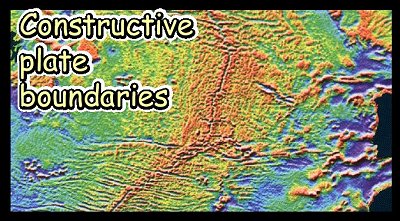 Constructive
plate boundaries are sites where new lithosphere is created - by sea floor spreading.
You can use this site to see the evidence for the creation of new sea floor,
from the pattern of magnetic anomalies. The relationship
between the age of the sea floor and its bathymetry - increasing away from ridges
- can be seen in a graph.
Constructive
plate boundaries are sites where new lithosphere is created - by sea floor spreading.
You can use this site to see the evidence for the creation of new sea floor,
from the pattern of magnetic anomalies. The relationship
between the age of the sea floor and its bathymetry - increasing away from ridges
- can be seen in a graph.
You can explore the origin of transform offsets on mid-ocean ridges, part of
the key evidence for the direction of relative plate
divergence. You can also look at the patterns of earthquakes in the central
part of the mid Atlantic Ridge.
The patterns of magnetic anomaly patterns on the sea floor can be seen on the
Juan de Fuca ridge for example. Refresh ideas on
calibrating magnetic layers
("magnetostratigraphy").
The formation of oceanic crust involves melting of underlying uppermantle.
The main way this occurs is by decompression - through passive up-welling. There
is more on this in the melting part of the site.
The result is a structured crust, classically determined from its seismic
velocity structure. Normally this reaches a thickness of about 6-7 km. However,
the thickness of ocean crust depends on the amount of melting in the underlying
mantle. More melting makes more melt and therefore thicker crust. and to get
more melting the mantle needs to melt hotter. Under Iceland the mantle is some
200C hotter than typical mantle - this is determined using seismic
tomography. Consequently Iceland crust reaches thicknesses
in excess of 20 km - and isostasy means some
of this thick crust pokes out of the water as dry land.
The image for the logo is part of a Seasat gravity map for the North Atlantic.
it shows the dramatic segmentation of the ridge by transform faults.

 Constructive
plate boundaries are sites where new lithosphere is created - by sea floor spreading.
You can use this site to see the evidence for the creation of new sea floor,
from the pattern of magnetic anomalies. The relationship
between the age of the sea floor and its bathymetry - increasing away from ridges
- can be seen in a graph.
Constructive
plate boundaries are sites where new lithosphere is created - by sea floor spreading.
You can use this site to see the evidence for the creation of new sea floor,
from the pattern of magnetic anomalies. The relationship
between the age of the sea floor and its bathymetry - increasing away from ridges
- can be seen in a graph.